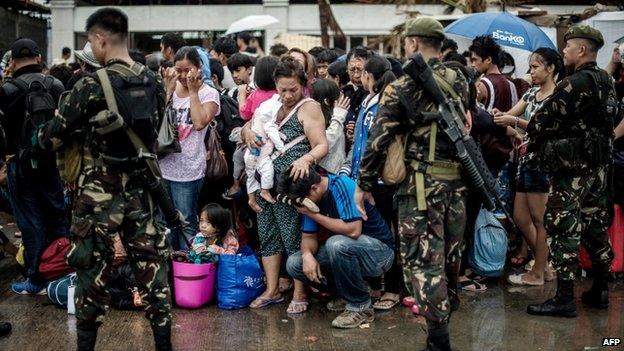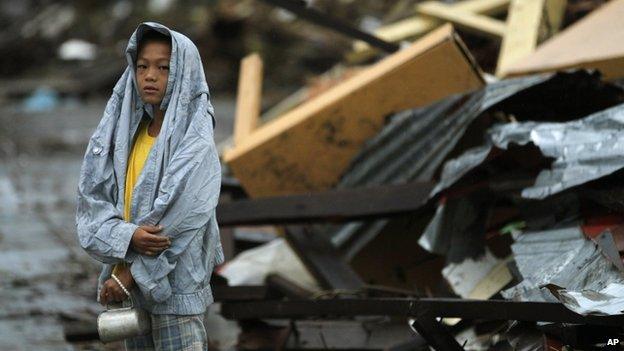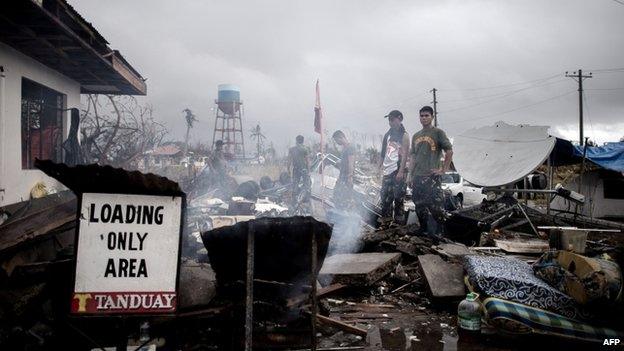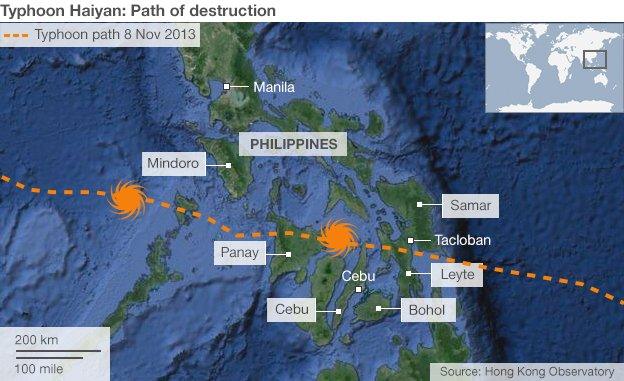Typhoon Haiyan: Ships head to Philippines amid devastation
- Published
The BBC's Jon Donnison reports from a street destroyed by "a wall of water"
US and British vessels were heading to the Philippines as the UN appealed for aid amid the large-scale devastation caused by Typhoon Haiyan.
The US has deployed an aircraft carrier and navy ships, while the UK is sending a naval destroyer.
At least 10,000 people are feared to have been killed and thousands of survivors desperately require aid - but reports say little is getting through.
Philippine President Benigno Aquino has declared a state of national calamity.
In a statement, he said the two worst affected provinces, Leyte and Samar, had suffered massive destruction and loss of life.
He authorised the release of emergency relief funds and deployed troops to affected areas.
A huge international relief effort is also under way, but journalists and rescue workers at the scene, external say reaching areas affected by the storm is difficult.
Bernard Kerblat, who is overseeing the UNHCR response to the crisis, said some aircraft had landed in Cebu but distributing aid was difficult because of bad weather and damaged infrastructure.
"The rain is further complicating the effort for light vehicles, including trucks, to penetrate in areas wherever there's still a bridge left intact.
"The other bad news is that within the next 72 hours, we should see the arrival of yet another typhoon."

Large parts of the Philippines have been devastated by Typhoon Haiyan

In Tacloban, Leyte, hundreds have gathered at the airport for supplies or to try and leave the city

Thousands of survivors desperately need aid, including food and water

The Philippine president has declared a state of national calamity
'Heartbreaking'
The National Disaster Risk Reduction and Management Council, external (NDRRMC) said 1,774 people had been reported dead, 2,487 were reported injured and 82 were missing.
The death toll is expected to rise significantly in coming days.
More than 580,000 people had been displaced and 41,000 houses had been damaged, the NDRRMC added.
UN Secretary General Ban Ki-moon described images of the impact of the storm as "heartbreaking".
The UN would launch a large-scale humanitarian plan and allocate $25m (£15.5m) "to fund critical relief efforts", he said.
"Many thousands of people are reported to have died and almost 10 million people have been affected... Let us all show our solidarity with the people of the Philippines at this time of need," he added.
BBC correspondent Rupert Wingfield-Hayes reports on the "stinking black water" left behind
On Tuesday, heavy thunderstorms struck Tacloban, one of the areas worst-hit by the typhoon. Correspondents say driving rain has added to the misery of tens of thousands of people living amid the wreckage of their homes.
One of the most powerful storms on record to make landfall, Haiyan - named "Yolanda" by Philippine authorities - struck the coastal provinces of Leyte and Samar on Friday.
It then headed west, sweeping through six central Philippine islands.
Air Force Capt Antonio Tamayo told AP news agency the scene in Tacloban, one of the worst-hit areas, was "overwhelming".
"We need more medicine. We cannot give anti-tetanus vaccine shots because we have none.''
Officials said looting was widespread and order was proving difficult to enforce. Correspondents say many ordinary people are simply scavenging for the food and water needed to survive.
The government says it has deployed armoured vehicles to Tacloban to deter looters.
"We are circulating [the vehicles] in the city to show the people, especially those with bad intentions, that the authorities have returned," Interior Secretary Mar Roxas told DZMM radio.
Alison Wallace, chief executive of disaster relief charity Shelterbox, told the BBC that delivering aid safely would be a major concern.
"Security is going to be a big part of the operation," she said.
"We have to make sure that when the aid is delivered that we don't actually make the situation worse by creating difficult scenes for people - the aid has to be delivered fairly [and] with as much safety as possible."

'Dead bodies'
In a statement, external, the US said that aircraft carrier USS George Washington and other navy ships should arrive in the Philippines "within 48-72 hours".
"As needed, these ships and aircraft will be able to provide humanitarian assistance, supplies, and medical care in support of the ongoing efforts led by the government and military of the Republic of the Philippines," the statement said.
UK Prime Minister David Cameron announced that the Royal Navy destroyer HMS Daring would soon head to the disaster zone from Singapore.
It would take five days to arrive but once in the Philippines would bring engineering and first aid expertise, as well as the use of a Lynx helicopter.
Other countries have also pledged millions of dollars in assistance. Japan is providing $10m and Australia $9m in humanitarian aid, while New Zealand has pledged over $1m.
Reports from Tacloban say soldiers have been distributing food and water to some residents and the US military has sent marines to the city.
However, correspondents say that many in Tacloban have seen no evidence of aid at all.
UN humanitarian official John Ging said: "Many places are strewn with dead bodies".
"The first priority of response teams, once they were able to navigate their way into these areas, is to mobilise the burial of dead bodies because of the public health issues," he said.
"As we get more and more access we find the tragedy of more and more people killed in this typhoon," he added.
Footage captured by storm videographer Jim Edds reveals the strength of Typhoon Haiyan
'Flattened' city
More than nine million people have been affected in the Philippines. Many are now struggling to survive without food, shelter or clean drinking water.
On Tuesday, further details emerged of the extent of damage caused by the storm:
More than 1,200 deaths were reported in Leyte province. Tacloban, its provincial capital, was largely flattened by a massive storm surge. Hundreds of people gathered at the airport desperate for food and water, others trying to get a flight out
An aid convoy travelling to Tacloban was attacked, with troops shooting dead two of the attackers, reports said
At least 200 were killed in Samar province, the NDRRMC said. Samar's exposed easterly town of Guiuan - population 40,000 - is said to be largely destroyed
In Cebu, 63 people have been reported dead.
A 4.8-magnitude earthquake hit San Isidro, Bohol at 05:30 GMT, the US Geological Survey said. The quake was also felt in Cebu City, the government said. There have been no reported casualties so far.
Authorities had evacuated hundreds of thousands of people before the typhoon arrived, but many evacuation centres - schools, churches and government buildings - proved unable to withstand the winds and storm surges.
Haiyan brought sustained winds of 235km/h (147mph), with gusts of 275 km/h (170 mph) and waves as high as 15m (45ft). In some places, as much as 400mm (15.75 inches) of rain fell.
On Monday, the typhoon weakened into a tropical storm and reached Vietnam. State media said at least 13 people had died, although the fatalities appeared to have taken place during preparations for the storm, before it made landfall.
The storm then moved into southern China, triggering rainstorms in Guangxi province, state-run news agency Xinhua reported.
The heavy rains have left one dead and affected nearly one million people in Guangxi, Xinhua added.